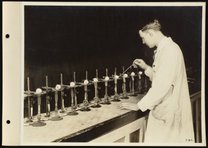Bunsen Burner
- Undated

 This work is licensed under a Creative Commons Attribution 4.0 International License.
This work is licensed under a Creative Commons Attribution 4.0 International License.An icon of experimental chemistry, as well as a standard piece of equipment in scientific laboratories and high school classrooms alike, the Bunsen burner was built in 1854 by Peter Desaga, an assistant in German scientist Robert Bunsen's laboratory. The burner included a gas control valve, modified from Michael Faraday's earlier design, producing a flame that was easily controlled, hot, and smokeless, making it ideal for laboratory work. The Bunsen burner quickly superseded earlier heating apparatuses, such as spirit lamps, coal, and oils. The simple, inexpensive design remains largely unchanged today.
| Property | Value |
|---|---|
| Place of manufacture | |
| Format | |
| Genre | |
| Medium | |
| Extent |
|
| Inscription |
|
| Subject | |
| Rights | Creative Commons Attribution 4.0 International License |
| Credit line |
|
Institutional location
| Department |
|---|
Learn More
Related Items
Cite as
Science History Institute. Bunsen Burner. Photograph, 2016. Science History Institute. Philadelphia. https://digital.sciencehistory.org/works/5138jd91b.
This citation is automatically generated and may contain errors.






